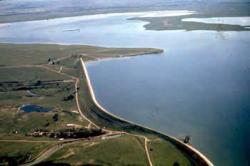
Belle Fourche, meaning "Beautiful Forks" in French, refers to the confluence of the Redwater and Belle Fourche Rivers. The gold rush to the Black Hills in 1876 brought many people to the area, but agriculture and livestock soon became the principal industries. Farmers and civic leaders recognized the need for a reliable source of irrigation water in this semi-arid region and petitioned the Federal government for funds to build an irrigation and flood control system.
When completed, the Belle Fourche Dam was the largest homogeneous, rolled-earth fill dam in the world. Belle Fourche has also been known as the Orman Dam and the Owl Creek Dam.
Facts
- The dam is constructed of compacted clay. The U.S. Geological Survey tested potential clay fill material for soluble salts to minimize percolation through the dam. Borrow areas containing more than two percent soluble salts were rejected for use in the dam.
- The soil was spread by road scrapers in 6-inch-thick layers, wetted, and compacted using 21-ton traction engines with 3-foot-wide wheels. After the soil was compacted, soil samples were obtained with a post auger and visually inspected to evaluate the clays consistency and moisture. Because the fields of soil mechanics and earthen dam construction were in their infancy, many of the soil testing and construction methods used were at the forefront of the technology of the day.
- Construction began in March 1906 for the big dam. In January 1908, with the dam only 25% complete contractors Orman & Crook declared bankruptcy. The bonding company hired another firm that finished the project.
- Water from the Belle Fourche River is diverted into the main canal by a diversion dam 2600 feet long and 36 feet in height. The main canal the conveys water to the reservoir behind the Belle Fourche Dam, an off-stream reservoir.


